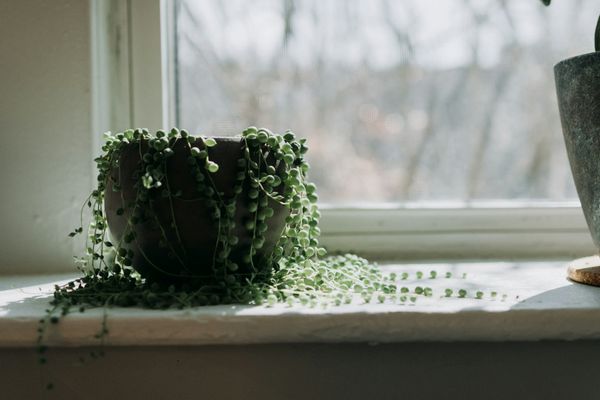String of Pearls Care Guide
How to grow and care for String of Pearls (Senecio rowleyanus)
Senecio rowleyanus, commonly known as String of Pearls, is a unique and visually appealing succulent characterized by its cascading strands of spherical, pearl-like leaves. This plant is popular for indoor gardening due to its distinctive appearance and relatively low maintenance needs, making it an excellent choice for beginners and experienced plant enthusiasts alike.

Disclosure: This content includes affiliate links, which means we may earn a commission if you click on a link and make a purchase. As an Amazon Associate, we earn from qualifying purchases. This comes at no extra cost to you and helps offset the cost of running Leafwise. Please read our disclaimer for more info.
Table of Contents
Care
Light
String of Pearls thrive in bright, indirect light. An east- or west-facing window is ideal. For best results, provide overhead lighting—either from a grow light or by placing the plant on a lower shelf—to promote even, compact growth at the top. While some morning sun is tolerated, prolonged exposure to intense midday rays can scorch the leaves.
Watering
Water thoroughly until excess drains from the pot, then allow the soil to dry completely before watering again. During the growing season (spring and summer), water every 2–3 weeks, adjusting based on environmental conditions. In fall and winter, reduce watering to once a month or less. Always check the soil before watering to prevent root rot.
Humidity and Temperature
String of Pearls prefer average indoor humidity but may benefit from occasional misting during particularly dry periods. Ideal temperatures range from 70–80°F (21–27°C) during active growth. In winter, maintain temperatures above 50°F (10°C) and avoid placing the plant near cold drafts or heat vents.
Soil
Use a well-draining cactus or succulent mix. To improve drainage, amend with perlite, coarse sand, or pumice. Ensure the pot has drainage holes to prevent water from accumulating at the roots.
Fertilization
Fertilize monthly during the growing season with a balanced, diluted succulent fertilizer. Discontinue feeding during fall and winter when the plant is dormant.
Maintenance
Pruning
Pruning is generally optional, but you can trim vines to control length or encourage fuller growth. Use clean, sharp scissors to avoid introducing disease.
Cleaning
Remove dust gently using a soft brush or cloth to keep the pearls clean and allow for optimal light absorption.
Repotting
Repot every 2–3 years or when the plant becomes root-bound. Signs include roots protruding from drainage holes, water pooling on the surface, or slowed growth. Choose a pot just slightly larger than the current one and refresh the soil for optimal drainage.
Propagation
String of Pearls propagate easily through stem cuttings. You can also loop vines back into the soil to encourage fuller growth.
- Cut a healthy vine about 2–3 inches long.
- Let the cut end callous for a day.
- Lay the cutting on top of moist succulent soil, ensuring several nodes touch the soil.
- Alternatively, loop existing vines across the surface to root at multiple points.
- Mist lightly and place in bright, indirect light.
- Roots typically develop within a few weeks. Check by gently tugging—resistance or new growth indicates success.
Common Issues
Pests
String of Pearls can be vulnerable to spider mites and mealybugs.
- Symptoms: Fine webbing, white cottony spots, or yellowing leaves.
- Solution: Treat with insecticidal soap or neem oil. Regularly inspect and isolate affected plants.
Root Rot
- Symptoms: Mushy, blackened roots; foul-smelling soil; wilting or collapsing stems.
- Causes: Overwatering, poor drainage, or pots without drainage holes.
- Solution: Remove from pot, trim rotted roots with sterilized scissors, allow healthy roots to dry, then repot in fresh, well-draining soil. Resume watering only after the soil is fully dry.
Yellowing
- Symptoms: Yellowing leaves.
- Causes: Overwatering or exposure to harsh sunlight.
- Solution: Let soil dry completely between waterings and move the plant to a bright, filtered light location.
With proper lighting, soil, and watering practices, your String of Pearls will flourish as a striking, cascading accent in any indoor space.
Note: String of Pearls is toxic if ingested by pets or humans. Keep it out of reach of children and animals.
